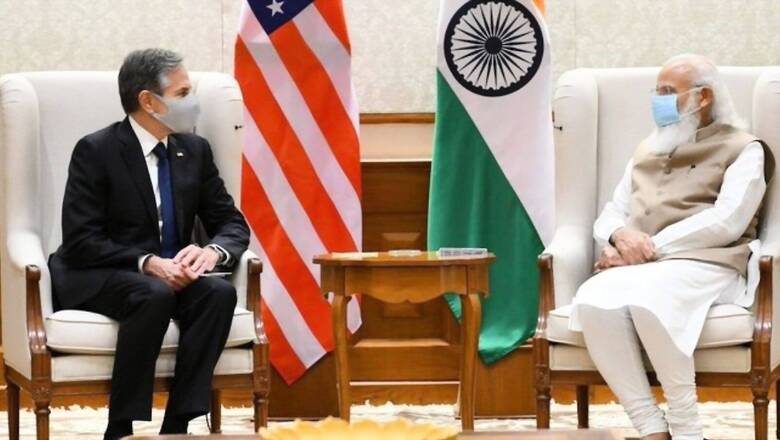
views
The Indian government has had most engagements with the United States within the first six months of any US administration in the past. In fact, within the first seven days of India has interacted with the US thrice, including a recent telephonic conversation between the US army chief of staff and his Indian counterpart.
Author and senior fellow at Brookings Institution, Tanvi Madan, on Sunday posted a tweet with a list of interactions there has been between the two countries in the span of the last six months.
???????????????? I've said that this is the most engagement the Indian & US governments have had in the first six months of any US administration. Why do I say that? Take a look at this list, which is reflective (though incomplete)… pic.twitter.com/RyNcqVoXIh
— Tanvi Madan (@tanvi_madan) August 7, 2021
Just weeks ago, US Secretary of State Antony Blinken was in India on his first official visit to the country since attaining office under the new Joe Biden-led US government. During his visit, Blinken held extensive talks with Prime Minister Narendra Modi, Indian External Affairs Minister S Jaishankar and National Security Advisor Ajit Doval on matters of domestic and international affairs such as the pandemic and Taliban.
A Fruitful Blinken Visit
In an exclusive interview with CNN-News18’s Managing Editor Zakka Jacob, Blinken had mentioned about the US working with India on an open and free Indo-pacific region, on providing Pfizer-Moderna vaccines, and also about a solution to the conflict in Afghanistan post the United States’ withdrawal of its troops.
During the interview, Blinken reiterated the American acknowledgement of India’s support when the US was reeling hard under the pandemic. “India came to our rescue by providing help. We did the same when India suffered, and our private sector came together to help people,” he said.
However, India’s request to lift the embargo on the export of raw materials from the US was initially met with resistance from the Biden Administration, following which the US received severe criticism from all quarters and later changed its stance. In fact, United States went a step further and announced to donate millions of vaccines to India under the COVAX initiative on 3 June 2021.
India is yet to receive the vaccine promised by the United States under the COVAX initiative.
However, the US-India relationship under the current Biden administration is being propelled by a broad convergence of interests—economic, political, defence and strategic.. Jaishankar had recently noted that the ties today “cover virtually all domains of contemporary relevance”. It would not be hyperbole to suggest that the two nations have successfully transitioned from estranged democracies (as Deputy Secretary of State Strobe Talbott famously remarked) to engaged strategic and global partners.
Bilateral Hiccups During Trump Era
The bilateral relations between the two countries were in choppy waters during four years of Donald Trump’s presidency as it was replete with frequent sour statements coming from the former US President himself, along with tough trade ties.
To begin with, rump had introduced strict H-1B restrictions to discourage immigration of Indians during his presidency. Of all the dramatic changes wrought by Trump, none had inspired more anxiety and worries for Indians than the restrictions against US work visas for foreign job-seekers.
Soon after assuming office, the Biden administration had rolled back visa rules that had put up hurdles in the path of those eager to pursue the American dream.
In brief, the US Department of Homeland Security (DHS) this week withdrew an order that was passed by the Trump administration last year aimed at narrowing the definition of “specialty occupation” under the H-1B visa regime.
Last year, in October, Trump had even described the air in India and China as “filthy” during the presidential debate over tackling climate change. “Look at China, how filthy it is. Look at Russia, look at India — it’s filthy. The air is filthy,” Trump said at the debate in Nashville. The statement had not gone down well.
Tariff Troubles
Seemingly, for Trump India was more as a business partner with give and take approach, be it foreign affairs, defence, trade or information-technology relationship. It was more of a transactional nature of relationship. While he spoke for a broader economic relationship with India, he pushed India to give America more access to the Indian markets nevertheless. His America First policy said India is a tariff king with unfair trade practices.
Biden’s focus is also on protecting the interests of the US companies but Obama-Biden administration worked amicably to rule out the trade differences between India and America and we may see the trade tension easing.
When it comes to IT industry, Trump has been particularly hostile. His anti-immigrant policy targets IT professionals from India. He sees H1B visa for IT professionals as a cheap labour programme and has vowed to end it. In July, he suspended the H1B visa programme. Biden, on contrary, looks like a saviour. He says he will secure the values as a nation of immigrants. He says he will be less harsh and will lift the H1B ban if elected and will increase the number of visas for permanent work-based immigration or the Green Card system.
Challenges Ahead
‘The Quad’ initiative, comprising the United States, India, Australia and Japan has been emphasised by Blinken as “not a military alliance” like the NATO.
The “Quad Vaccine Partnership” initiative has recently sought for India to ramp up its vaccine production capabilities to help immunise the world, despite India’s generous export of 60 million doses of vaccine from February to April under its Vaccine Maitri (“Vaccine Friendship”) program.
Read all the Latest News, Breaking News and Coronavirus News here.















Comments
0 comment